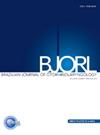Expression of ApoE and Spp1 in the cochlea and auditory cortex of age-related hearing loss mice
IF 1.7
4区 医学
Q2 OTORHINOLARYNGOLOGY
引用次数: 0
Abstract
Objective
Screen for differential proteins in the cochlea of mice associated with Age-Related Hearing Loss (ARHL), analyze and validate the expression of specific differential proteins and genes in the cochlea and auditory cortex of ARHL mice, and preliminarily explore their potential mechanisms of action.
Methods
ABR (Auditory Brainstem Response) hearing tests were conducted to select 15-month-old C57BL/6 mice with significantly decreased hearing as the experimental group and 2-month-old mice with normal hearing as the control group. Cochleae were dissected, and unlabeled quantitative proteomics was employed to identify and analyze differentially expressed proteins in the inner ear of the two groups of mice. Key node proteins were selected via the STRING database and Cytoscape analysis. The expression of two selected proteins, ApoE and Spp1, in the cochlea was detected using qRT-PCR, Western blot, and immunofluorescence techniques, and their expression in the auditory cortex of the brain was further explored.
Results
Label-free quantitative proteomics identified 115 differentially expressed proteins in the cochlea of 15-month-old ARHL mice compared to 2-month-old hearing-normal mice, including 42 upregulated and 73 downregulated proteins. GO and KEGG enrichment analyses revealed significant enrichment of differentially expressed proteins in functions and signaling pathways associated with neurodegenerative diseases and neurotransmission. Protein-Protein Interaction (PPI) analysis using the STRING database and Cytoscape selection identified ApoE and Spp1 as key hub proteins. Validation via qRT-PCR, Western blot, and immunofluorescence demonstrated that both ApoE and Spp1 were highly expressed in the cochlea and auditory cortex of the ARHL mice compare to 2-month-old hearing-normal mice.
Conclusion
ApoE and Spp1 are upregulated in the cochlea of ARHL mice, particularly in spiral ganglion neurons, and in the auditory cortex, suggesting their potential involvement in the pathogenesis and progression of ARHL through the modulation of auditory neural conduction systems.
Level of evidence
Level 2.
ApoE和Spp1在老年性听力损失小鼠耳蜗和听觉皮层的表达
目的筛选与年龄相关性听力损失(Age-Related Hearing Loss, ARHL)相关小鼠耳蜗中的差异蛋白,分析并验证ARHL小鼠耳蜗和听觉皮层中特异性差异蛋白和基因的表达,并初步探讨其可能的作用机制。方法选择15月龄听力明显下降的C57BL/6小鼠作为实验组,2月龄听力正常的小鼠作为对照组,进行听觉脑干反应(sabr)听力测试。解剖耳蜗,采用未标记定量蛋白质组学方法对两组小鼠内耳差异表达蛋白进行鉴定分析。通过STRING数据库和Cytoscape分析选择关键节点蛋白。采用qRT-PCR、Western blot和免疫荧光技术检测ApoE和Spp1两种蛋白在耳蜗中的表达,并进一步探讨其在大脑听觉皮层中的表达。结果15月龄ARHL小鼠耳蜗与2月龄听力正常小鼠相比,鉴定出115种差异表达蛋白,包括42种上调蛋白和73种下调蛋白。GO和KEGG富集分析显示,与神经退行性疾病和神经传递相关的功能和信号通路中差异表达蛋白显著富集。利用STRING数据库和Cytoscape筛选进行蛋白-蛋白相互作用(PPI)分析,确定ApoE和Spp1为关键枢纽蛋白。通过qRT-PCR、Western blot和免疫荧光验证,与2月龄听力正常的小鼠相比,ApoE和Spp1在ARHL小鼠的耳蜗和听觉皮层中均有高表达。结论apoe和Spp1在ARHL小鼠耳蜗,尤其是螺旋神经节神经元和听觉皮层中表达上调,提示它们可能通过调节听觉神经传导系统参与ARHL的发病和进展。证据等级:2级。
本文章由计算机程序翻译,如有差异,请以英文原文为准。
求助全文
约1分钟内获得全文
求助全文
来源期刊

Brazilian Journal of Otorhinolaryngology
OTORHINOLARYNGOLOGY-
CiteScore
3.00
自引率
0.00%
发文量
205
审稿时长
4-8 weeks
期刊介绍:
Brazilian Journal of Otorhinolaryngology publishes original contributions in otolaryngology and the associated areas (cranio-maxillo-facial surgery and phoniatrics). The aim of this journal is the national and international divulgation of the scientific production interesting to the otolaryngology, as well as the discussion, in editorials, of subjects of scientific, academic and professional relevance.
The Brazilian Journal of Otorhinolaryngology is born from the Revista Brasileira de Otorrinolaringologia, of which it is the English version, created and indexed by MEDLINE in 2005. It is the official scientific publication of the Brazilian Association of Otolaryngology and Cervicofacial Surgery. Its abbreviated title is Braz J Otorhinolaryngol., which should be used in bibliographies, footnotes and bibliographical references and strips.
 求助内容:
求助内容: 应助结果提醒方式:
应助结果提醒方式:


